There’s something magical about Galway City, a place where history and vibrant modern life blend effortlessly. And we are very proud of our heritage, that’s why we included some of the iconic Galway City landmarks in our labels bottle. Join us on a walk through some of Galway’s most charming streets!
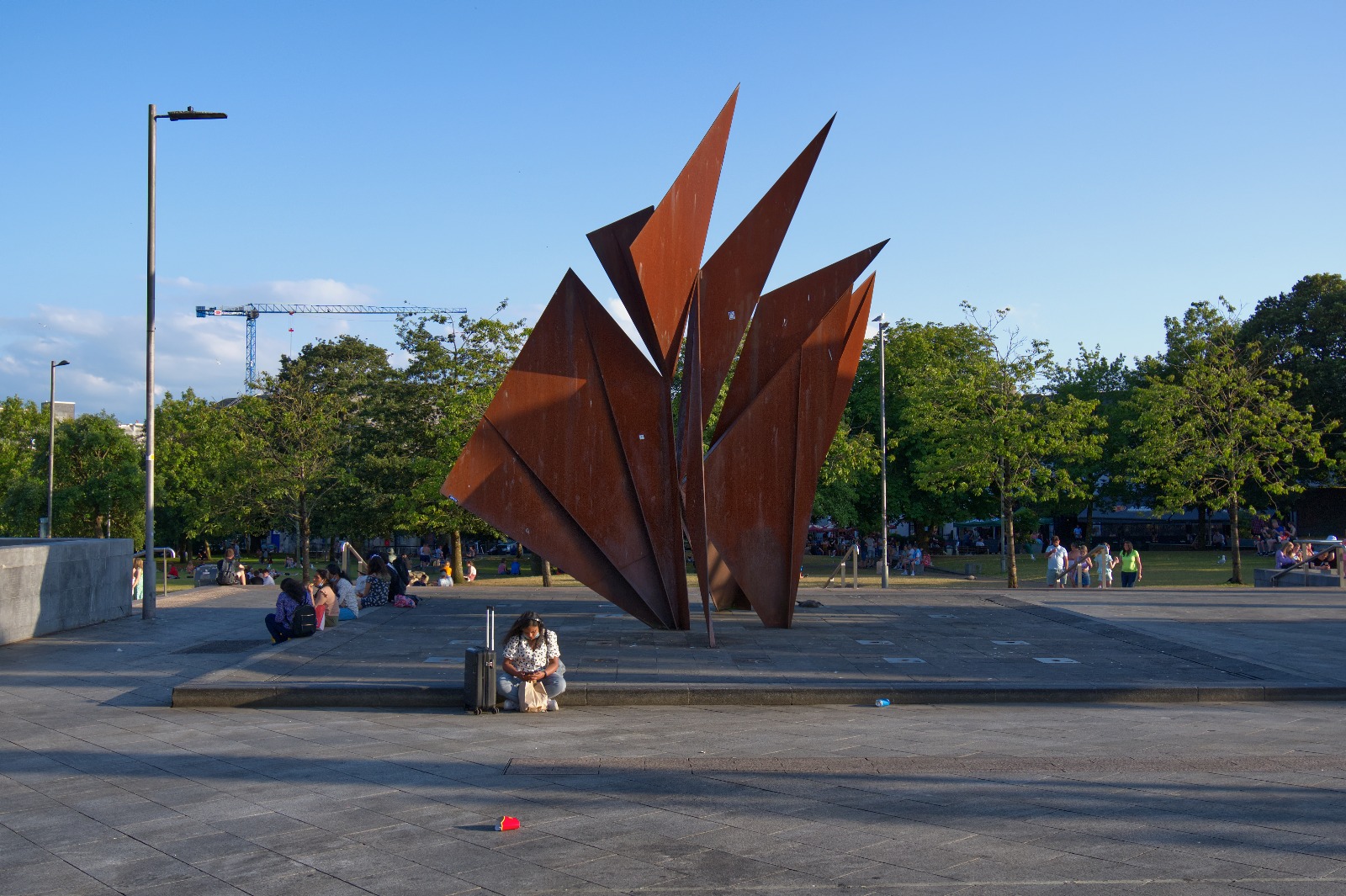 As you make your way to the top of the square you will spot the coat of arms of the 14 Tribes of Galway—the powerful merchant families who once ruled the city. Take some time to admire these beautiful flags.
As you make your way to the top of the square you will spot the coat of arms of the 14 Tribes of Galway—the powerful merchant families who once ruled the city. Take some time to admire these beautiful flags.As you make your way between the flags, you’ll come across a beautifully preserved remnant of Galway’s past—Browne’s Door.
This striking doorway is all that remains of a grand 1627 mansion that once stood on Abbeygate Street. Originally the entrance to the home of the Browne family—one of the influential Tribes of Galway—it exemplifies Renaissance-style architecture, featuring Tuscan columns, intricate carvings, and coats of arms honoring Martin Browne and Marie Lynch. Having withstood Galway’s turbulent history, the doorway survived the Cromwellian conquest of 1652, which saw much of the city, including the Browne residence, seized and destroyed. It was relocated to Eyre Square in 1905, and now stands as a proud symbol of Galway’s rich architectural and civic heritage, as well as Galway’s resilience and strength.
Just a skip and a jump from Eyre Square, take a lively walk down Shop Street, where buskers take the the streets to fill the air with music, adding to the city’s infectious energy.
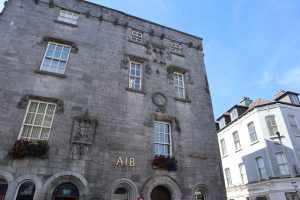
Along the way, we pass Lynch’s Castle, a medieval fortress now housing an AIB bank. Step inside the vestibule, where you can learn about the influential Lynch family, one of the original 13 Tribes of Galway.
Continuing our journey, we reach the historic King’s Head pub. Here, take a left onto Market Street, where the weekend Galway Market offers an array of local goods, from artisan crafts to fresh produce. Treat yourself to a delicious crêpe before stepping inside St. Nicholas’ Church, a medieval treasure where Christopher Columbus is rumored to have prayed before his voyage to the New World.
Just around the corner you’ll find Lynch’s Window, tied to one of Galway’s most infamous of legends. It is said that in the 1490s, Mayor James Lynch FitzStephen hanged his own son from this very window for the murder of a young Spaniard, leading to the local belief that this is where the verb “to be lynched” came from. Though historically untrue, the story remains a fascinating part of Galway’s lore.
Enter the Latin Quarter. Filled with bustling restaurants and bars such as The Kings Head, Taffes, Neachton’s, The Quay’s Bar or Kirwan’s Lane Restaurant you are sure to have a good time in this amazing area in Galway City.
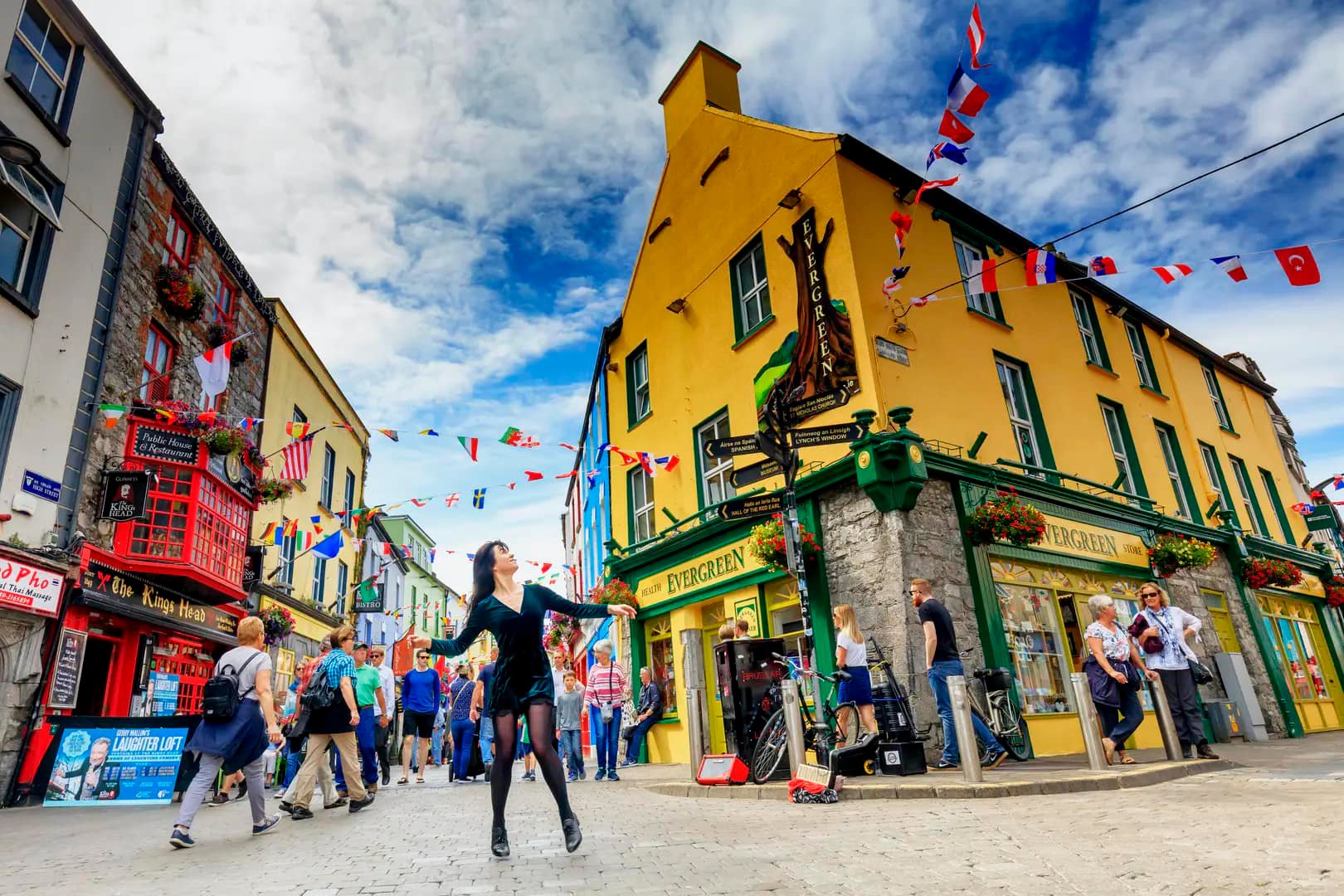
As your making your way down Quay Street make sure to pop into Thomas Dillon’s Jewelers—the birthplace of the Claddagh Ring and the Claddagh Ring Museum.

This famous ring, with its heart symbolising love, its hands symbolising friendship, and a crown for loyalty, over the years has become an enduring emblem of Irish heritage the world over.
The most well-known legend attributes its creation to Richard Joyce, a 17th-century Galway native who was captured by pirates and sold into slavery in North Africa, where he became a skilled goldsmith. Upon his release, he returned to Galway and crafted the first Claddagh Ring as a token of his enduring love. Nowadays you can find this beautiful ring in many jewelery shops in Ireland in a variety designs, including different birth stones for an even more personalised touch.
For some more local tales about the ring’s fascinating history and more importantly how to properly wear it (hint: the way you wear it let’s others know your heart is open and looking for love or not), head on in to Claddagh Celtic Jewellery on the corner where Quay Street meets Spanish Arch.
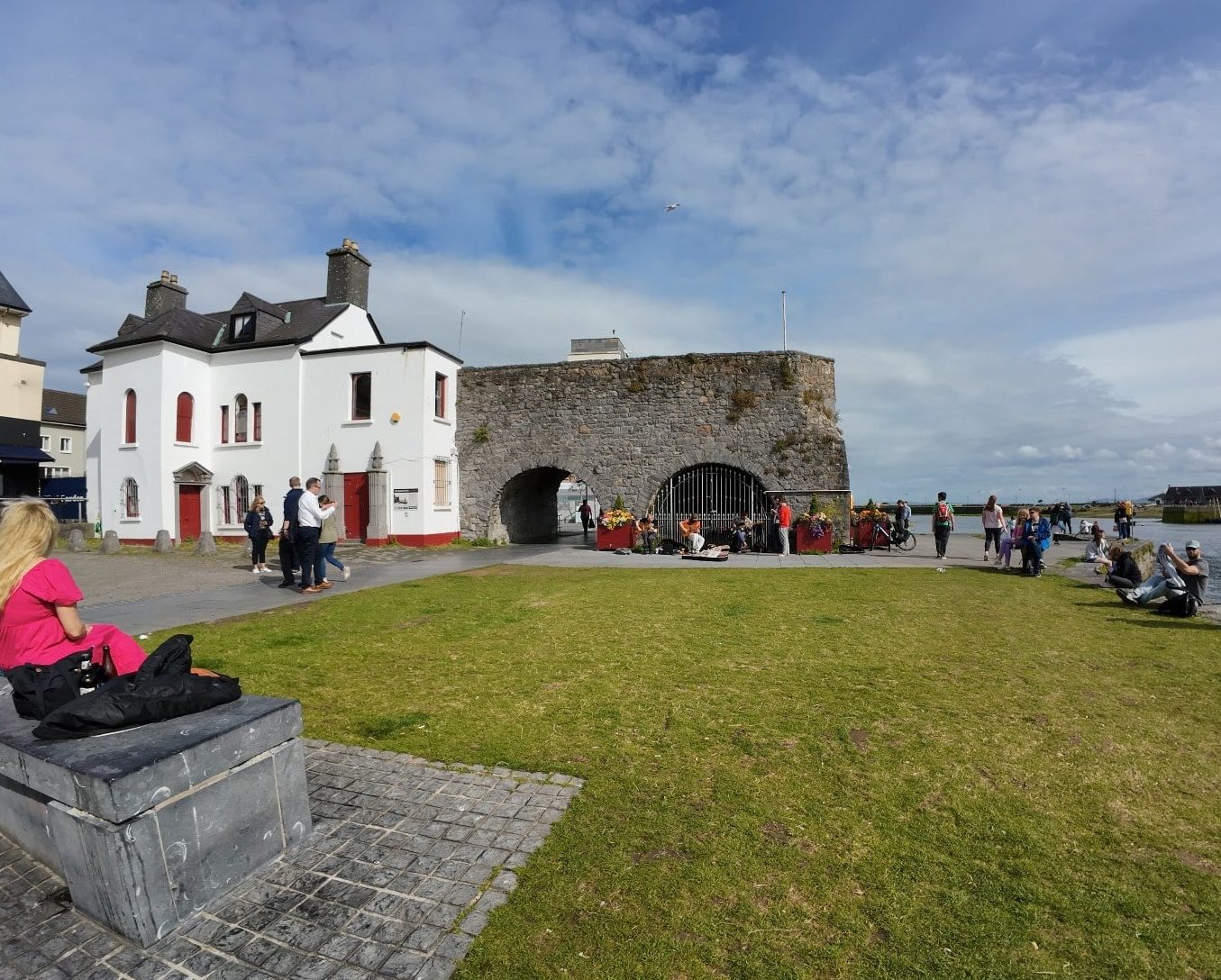
For many years, this little spot has been the gem in Galway City where locals flock to once the sunshine comes out! Known as “The Sparch” to us locals, many a days were spent here conversing, dancing and playing music with strangers and/or friends.
Our memories from those days spent here are so great, that it inspired our label – the first and still the second! If you’re lucky enough to be in Galway on a sunny day, be sure to come here for a vibrant, energetic experience you will treasure forever.
The arch you see in the picture is a remnant of the 16th-century city walls that once surrounded Galway City. Once forming part of Galway’s bustling port where traders from Spain and beyond docked their ships, this is how the landmark got its name.
Make your way through the arch to head to the Galway museum for more history and culture or to walk down the famous Long Walk with it’s colourful houses!Head on back through the Spanish Arch where you’ll spot the beautiful Galway Hookers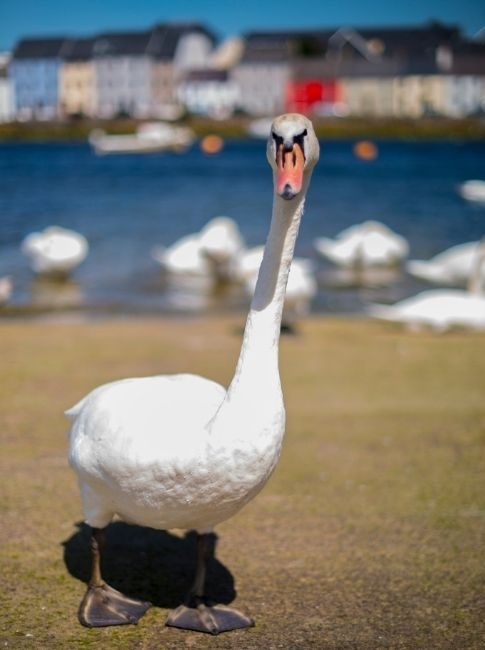 standing proudly across the river or cross the Wolfe Tone bridge for a closer look and meet the cute gliding swans!
standing proudly across the river or cross the Wolfe Tone bridge for a closer look and meet the cute gliding swans!
Ps. As you’re crossing the bridge, make sure to glance over to your right for a sneak peak at the green copper dome of the Galway Cathedral popping in the distance.
Once over the bridge – you have now entered the Claddagh where tradition and heritage are still felt today. Here, the Galway Hooker boat, with its distinctive dark red or rusty brown sails, remains a proud symbol of Galway’s seafaring past. These sturdy boats, renowned for their resilience and beauty, were once used for fishing and transporting goods like turf, livestock, seaweed, and poitín. Developed back in the late 18th century, the Claddagh was once the main boat-building hub of Connaught where only the most skilled boat-makers and fishermen made these by hand.
Making our way back towards the Leonardo Hotel, we take the scenic canal walk leading to the Salmon Weir Bridge. During the spring and early summer months this spot is famous for the salmon run, where lucky onlookers can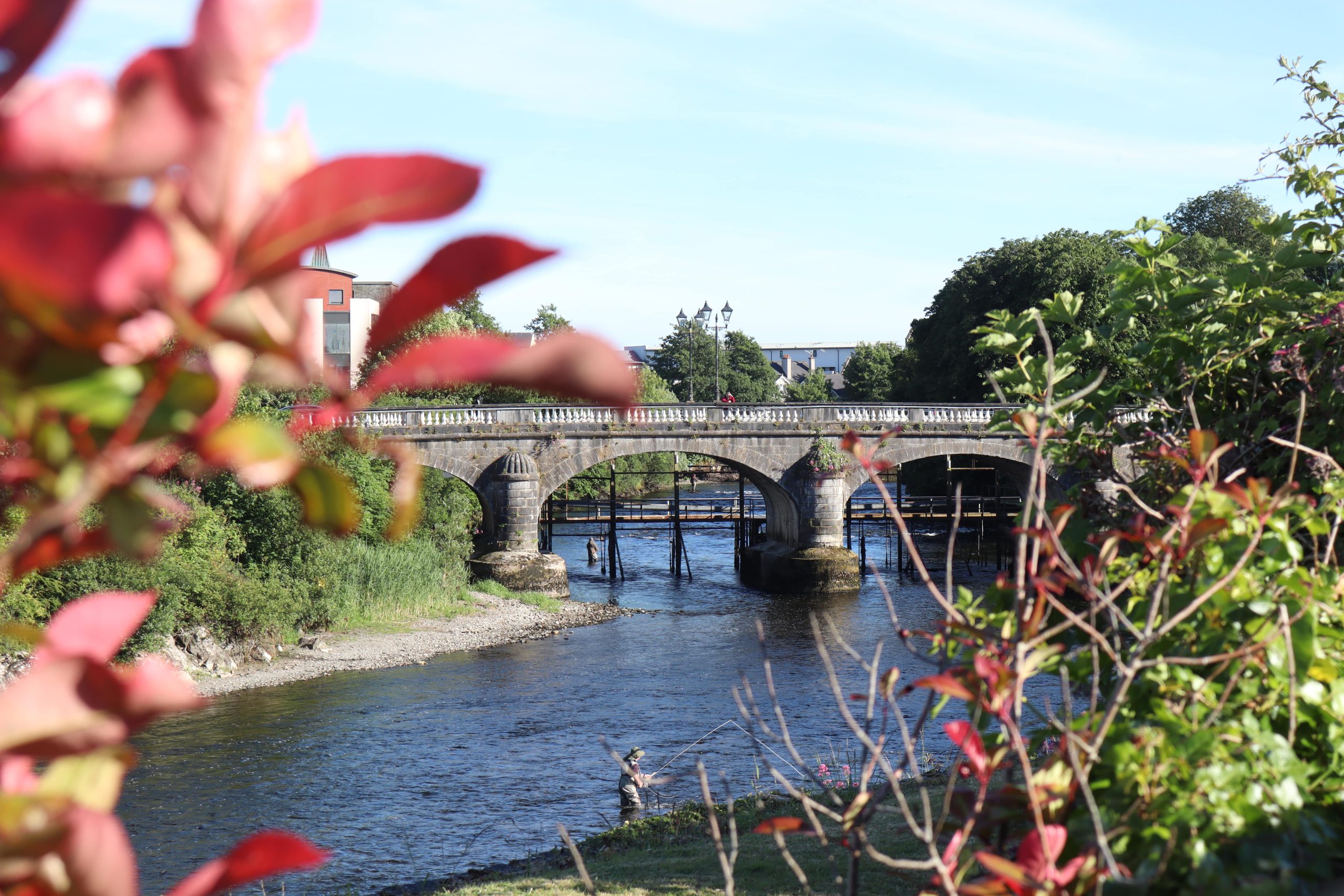 witness these remarkable fish leaping upstream through the Corrib River, making their way towards Lough Corrib to make babies.
witness these remarkable fish leaping upstream through the Corrib River, making their way towards Lough Corrib to make babies.
Just beyond the bridge, the Galway Cathedral stands proudly. Located on Nun’s Island, on the west bank of the River Corrib and once and English prison from the 1800’s til 1939, by 1965 this majestic structure became one of the city’s most striking landmarks and a symbol of Irish Independence.
If you visit in July, you’ll notice a striking blue tent to the right of the Cathedral – known as the Big Top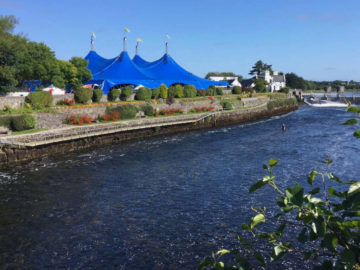 to Galwegians.
to Galwegians.
This music arena is part the Galway International Arts Festival (GIAF), a two-week extravaganza of music, theatre, and visual art that takes over the city in the last 2 weeks of July every year! Over the years, artists such as Chic, Leftfield, The Saw Doctors, Kneecap, the National, Sinéad O’Connor, and Blondie, to name a few, have graced its stage, making it a highlight of Galway’s cultural summer calendar.
Finally, we make our way to Salthill, a charming seaside village over looking Galway Bay. Head on back through the canals or walk the West End – another great spot filled with pubs, cafes and restaurant in our beautiful Galway.
Pop into Monroes or The Crane for some traditional Irish music before talking a stroll by the Claddagh towards Salthill. Once you reach Salthill, do as the locals do, and walk the Salthill prom. Follow a beloved tradition of kicking the wall at the end—a small but satisfying ritual.
If you’re looking for some fun and games, head in to Curry’s Fun Park for some thrilling rides or romantic times on the Sky Wheel, offering a breathtaking view of Galway Bay. And of course don’t forget to grab your swimsuit and take a dip in the calming waters of Salthill. Or if you’re brave enough, a dive off Blackrock’s famous diving tower into the Atlantic’s refreshing waters is a must!
Round the day off by relaxing at the newly refurbished Blackrock Cottage Café, enjoying a delicious meal paired with a refreshing Galway Cider as you watch the waves gently roll onto the shore. A perfect day spent in Galway City, where history, music, and coastal beauty combine to create an unforgettable experience.
Lastly (but certainly not least), meet the rampant lion in our label—a tribute to the city’s historic coat of arm, featured both the Galway GAA Crest and Galway United Crest.
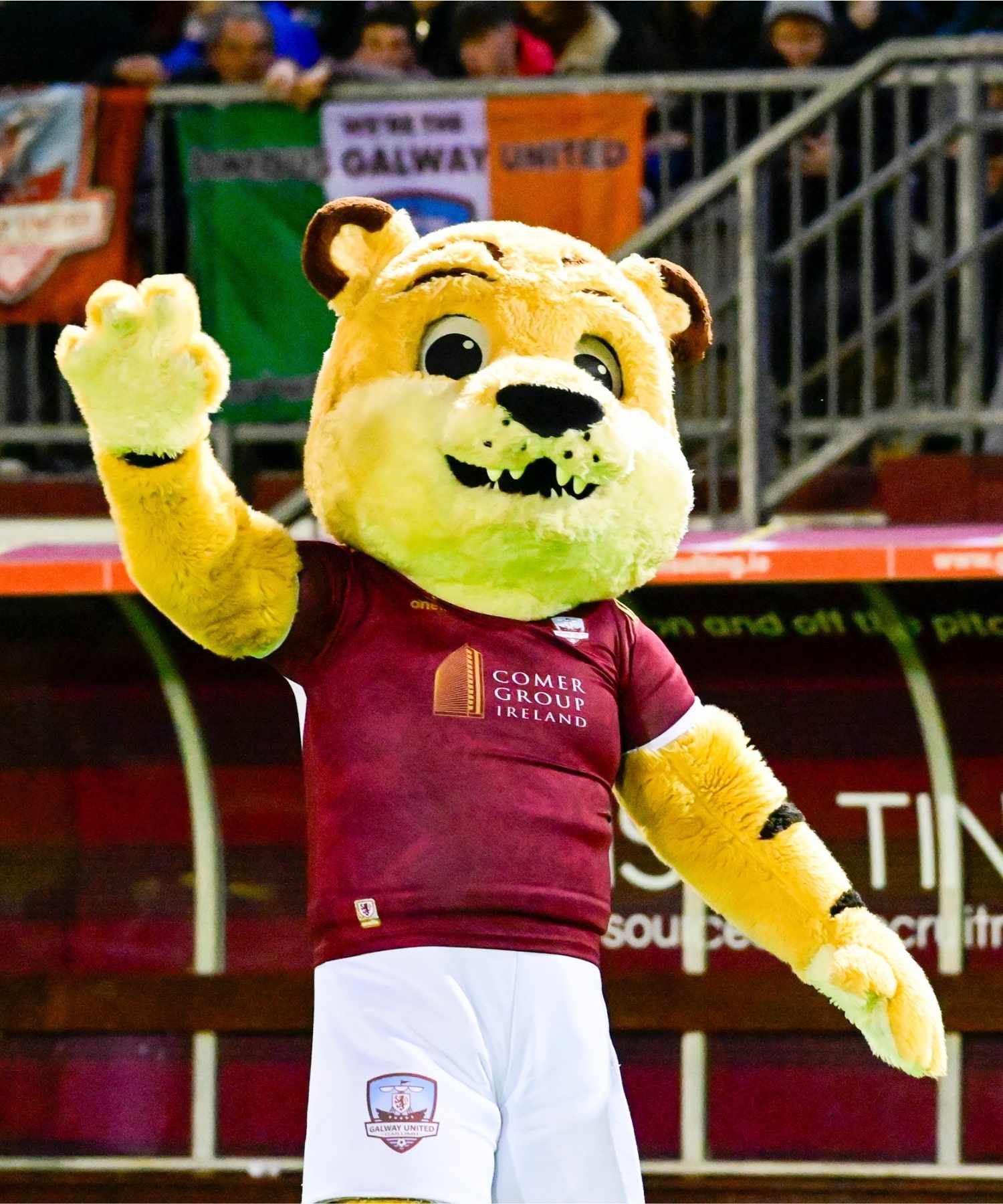
The rampant lion is a powerful sumbol of strength, courage, and heritage with deep historical ties to Galway. This emblem has long represented resilience and pride, which we think perfectly captures the fighting spirit and determination of Galwegians.
Home to passionate athletes and supporters, Galway is a sports-loving city. Whether it’s Gaelic football, hurling, or soccer, there’s no shortageof excitement. Visit Pearse Stadium to catch a thrilling Gaelic football game or hurling match, or head over to Eamonn Deacy Park for a Galway United soccer game, where the exuberant Terry the Tiger mascot keeps the energy high.
Home | Beautiful Galway | Find Us
Become A Stockist
Privacy Policy | Cookies Policy
Get in touch: francis@galwaycider.ie
091 741 848
H91VY3K
© Leann Ul na Gaillimhe, 2025. All rights reserved. Site by YellowLime Media & Marketing.
Home | Beautiful Galway | Find Us
Become A Stockist
Privacy Policy | Cookies Policy
Get in touch: francis@galwaycider.ie
091 741 848
H91VY3K
© Leann Ul na Gaillimhe, 2025. All rights reserved. Site by YellowLime Media & Marketing.
Home | Beautiful Galway | Find Us
Become A Stockist
Privacy Policy | Cookies Policy
Get in touch: francis@galwaycider.ie
091 741 848
H91VY3K
© Leann Ul na Gaillimhe, 2025. All rights reserved. Site by YellowLime Media & Marketing.

Home | Beautiful Galway | Find Us
Become A Stockist
Privacy Policy | Cookies Policy
Get in touch: francis@galwaycider.ie
091 741 848
H91VY3K
© Leann Ul na Gaillimhe, 2025. All rights reserved. Site by YellowLime Media & Marketing.